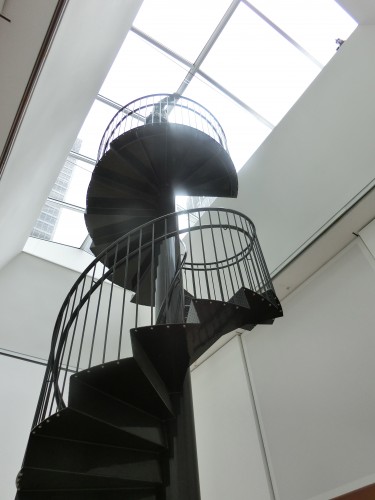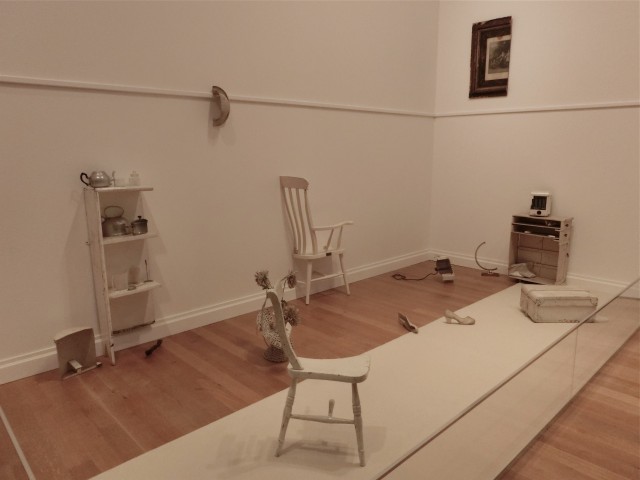
Yoko Ono’s “To See the Sky” offers visitors the chance to commune one-on-one with the heavens (photo by twi-ny/mdr)
Museum of Modern Art
The International Council of the Museum of Modern Art Exhibition Gallery, sixth floor
11 West 53rd St. between Fifth & Sixth Aves.
Through September 7, $25 (including audio program and film screenings)
212-708-9400
www.moma.org
In December 1971, Yoko Ono staged an unofficial one-woman show at MoMA, which she called the “Museum of Modern [F]art,” in which she supposedly released a glass jar full of flies into the sculpture garden, scattering art everywhere, even though a sign inside noted, “This Is Not Here.” Ono now has an honest-to-goodness solo show at MoMA, an involving and affecting retrospective of her conceptual work from 1960 through 1971, and although it’s titled “One Woman Show,” it’s about as participatory as these things can get. Visitors are invited to walk right on “Painting to Be Stepped On,” although many people still opt to carefully tiptoe around it; play a game of chess in the sculpture garden on “White Chess Set,” in which all of the pieces are white; slip under a black sheet and perform on a small stage for “Bag Piece”; make physical contact with others in “Touch Poem for a Group of People,” although the room was empty the several times I passed by; climb a rickety spiral staircase in “To See the Sky” and privately commune with the outside world via a skylight at the top; and choose to carry out any of the myriad instructions that comprise Ono’s storied Grapefruit book, though not necessarily right on the premises. However, you should not do what John Lennon did when he first met Ono in 1966 and take a bite out of the green apple that sits on a transparent pedestal at the opening of the exhibit. “Ono’s art has uncovered not only often concealed aspects of the act of engaging with an artwork (revealing, for instance, the central role the viewer plays in its creation) but also the ways in which cultural, social, and political life influence and affect each other,” explains MoMA curator-at-large Klaus Biesenbach in his catalog essay, “Absence and Presence in Yoko Ono’s Work,” continuing, “Looking back on her conceptual 1971 exhibition at the Museum of Modern Art, we see that she knew long ago that her groundbreaking practice warranted a solo exhibition there. Forty-four years later, that show is finally a reality, with the same radicality and presence it had when she first imagined it.”
The MoMA exhibition also includes such other Ono works as “Cut Piece,” a film by Albert and David Maysles of her sitting calmly as audience members cut off parts of her outfit; “A Box of Smile,” small boxes in a wall that provide pleasant surprises; “Film No. 4,” an onscreen procession of derrières; a room of paraphernalia and music she made with the Plastic Ono Band; “Fly,” which follows flies making their way across a woman’s naked body; footage of political demonstrations she and Lennon led, including “Bed-In”; and other drawings, sculptures, films, posters, invitations, and installations. There’s more in the exhibition catalog, which contains a number of essays and letters written by Ono in the section entitled “Yoko’s Voice”; in November 2014’s “Don’t Stop Me!” she writes, “Let me be free. Let me be me! Don’t make me old, with your thinking and words about how I should be. You don’t have to come to my shows. I am giving tremendous energy with my voice, because that is me. Get my energy or shut up.” She might have been referring specifically to her live musical performances, but the admonition relates to this early-career retrospective as well. Many people come to Ono and her work with a preconceived notion of who she is and what she does, often negative; “Yoko Ono: One Woman Show, 1960-1971” reveals her to be a much misunderstood artist who actually has a lot to say about the state of humanity, nearly universally positive, still seeking to attain world peace. And what’s wrong with that? (The final week of the show will feature the Gallery Sessions programs “Yoko Ono: From Grapefruit to Green Apple” on August 31 at 1:30 and September 2-3 at 11:30, “Yoko Ono: One Woman Show, 1960-1971” on September 5 at 1:30, and “Make Your Own Yoko Ono Piece” on September 6 at 11:30, and museumgoers can sit down and play on Ono’s “White Chess Set” in the sculpture garden on Tuesday, Wednesday, Friday, and Saturday from 1:00 to 4:00.)
